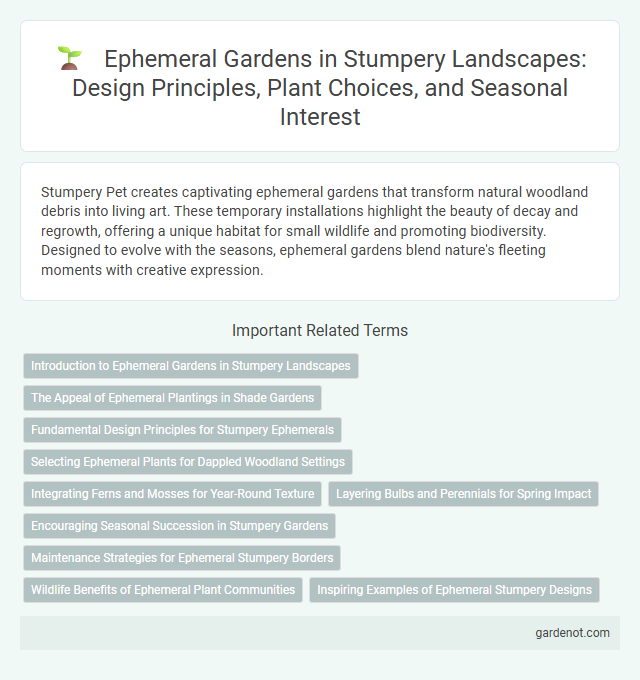Stumpery Pet creates captivating ephemeral gardens that transform natural woodland debris into living art. These temporary installations highlight the beauty of decay and regrowth, offering a unique habitat for small wildlife and promoting biodiversity. Designed to evolve with the seasons, ephemeral gardens blend nature's fleeting moments with creative expression.
Introduction to Ephemeral Gardens in Stumpery Landscapes
Ephemeral gardens in stumpery landscapes showcase transient botanical arrangements nurtured on decaying wood and natural debris, creating dynamic ecosystems that emphasize seasonal change and organic decay. These gardens highlight the interplay between fungi, mosses, and shade-loving plants, offering a unique habitat that evolves over time and enriches biodiversity. The incorporation of ephemerality in stumpery design celebrates nature's life cycle, transforming fallen timber into living art that flourishes briefly before returning to the soil.
The Appeal of Ephemeral Plantings in Shade Gardens
Ephemeral plantings in shade gardens offer a dynamic display of seasonal beauty by showcasing fleeting blooms and delicate foliage that thrive in low-light conditions. These temporary installations enhance the natural mystery of shade landscapes, providing ever-changing textures and colors that evoke a sense of discovery. Emphasizing native ferns, wildflowers, and shade-loving bulbs ensures ecological harmony and supports local biodiversity.
Fundamental Design Principles for Stumpery Ephemerals
Stumpery ephemerals thrive on principles of contrast, texture, and seasonal sensitivity, emphasizing the natural interplay between decayed wood and delicate, short-lived plants. Effective design integrates organic irregularity with thoughtfully arranged ephemeral species that highlight fleeting beauty and ecological succession. Prioritizing moisture retention and habitat mimicry ensures these temporary structures support biodiversity while celebrating transience in garden aesthetics.
Selecting Ephemeral Plants for Dappled Woodland Settings
Selecting ephemeral plants for dappled woodland settings involves choosing species that thrive in partial shade and take advantage of early spring sunlight before tree canopies fully develop. Ideal plants include native spring ephemerals like trilliums, bloodroot, and yellow trout lilies, which complete their lifecycle quickly and add vibrant bursts of color. These species adapt well to the moist, leaf-litter-rich soil and contribute to a dynamic, ever-changing stumpery environment.
Integrating Ferns and Mosses for Year-Round Texture
Integrating ferns and mosses in a stumpery creates a textured, year-round garden display by utilizing their natural shade tolerance and moisture retention. Ephemeral gardens benefit from the lush, resilient greenery of ferns and mosses, maintaining visual interest through seasonal changes. These plants enhance biodiversity, providing habitats for invertebrates while enriching the microclimate of the garden space.
Layering Bulbs and Perennials for Spring Impact
Layering bulbs and perennials in a stumpery creates a dynamic, ephemeral garden that bursts with color throughout spring. By planting early-flowering bulbs like crocuses and snowdrops beneath taller perennials such as hellebores and pulmonarias, you maximize bloom duration and visual interest. This strategic layering ensures continuous flowering, enhancing the textured, woodland-inspired aesthetic typical of stumpery designs.
Encouraging Seasonal Succession in Stumpery Gardens
In a stumpery garden, encouraging seasonal succession enhances biodiversity by carefully selecting plants that thrive in different seasons, such as hellebores in winter, ferns and hostas in spring, and shade-loving perennials in summer. Utilizing decaying wood structures supports moisture retention and soil health, promoting continuous growth cycles while providing habitats for beneficial insects and fungi. This dynamic approach ensures a visually appealing and ecologically balanced stumpery throughout the year.
Maintenance Strategies for Ephemeral Stumpery Borders
Ephemeral stumpery borders require specialized maintenance strategies focusing on moisture retention and regular inspection for decay to preserve their structural integrity and aesthetic appeal. Incorporating mulch around stumps enhances soil moisture while minimizing weed growth, crucial for supporting ephemeral plantings like ferns, mosses, and bulbs. Periodic pruning of surrounding plants prevents overgrowth, ensuring light penetration and airflow to sustain the delicate balance of the ephemeral garden ecosystem.
Wildlife Benefits of Ephemeral Plant Communities
Ephemeral plant communities in stumperies provide critical habitats and food sources for diverse wildlife, supporting pollinators, insects, and small mammals during brief growing periods. These transient ecosystems contribute to soil health and biodiversity by promoting nutrient cycling and offering shelter in shaded garden microhabitats. By mimicking natural woodland processes, ephemeral gardens enhance urban wildlife corridors and foster ecological resilience.
Inspiring Examples of Ephemeral Stumpery Designs
Ephemeral stumpery designs showcase the beauty of decaying wood artfully arranged to create temporary garden sculptures that highlight natural textures and organic forms. Notable examples include intricate moss-covered root displays and layered twig structures that evolve with seasonal changes, enhancing woodland aesthetics. These fleeting installations emphasize ecological harmony and artistic creativity, offering garden enthusiasts innovative inspiration for sustainable, nature-focused landscaping.
Ephemeral garden Infographic

 gardenot.com
gardenot.com